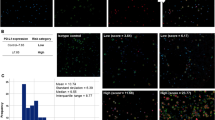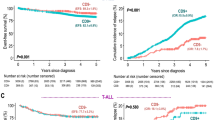Abstract
Lack of CD56 expression was reported to be associated with a poor prognosis in multiple myeloma (MM) patients treated with conventional chemotherapy. Aim of our retrospective study was to analyse whether CD56 expression on MM cells reveals as a prognostic factor in patients treated with high-dose chemotherapy. MM cells of 99 patients prior to treatment with high-dose chemotherapy were analysed for CD56 expression by flow cytometry. Multivariable analysis of event-free survival in these patients showed no statistically significant difference between the CD56− (n=28) and the CD56+ (n=71) group. The lack of CD56 expression on MM cells of these patients correlated significantly with the presence of translocation (11;14) (t(11;14)) (estimated correlation coefficient=0.655 95%, confidence interval (0.481; 0.779)). In summary, our results indicate that lack of CD56 expression on MM cells is not a prognostic marker in patients treated with high-dose chemotherapy, but is associated with t(11;14).
This is a preview of subscription content, access via your institution
Access options
Subscribe to this journal
Receive 12 print issues and online access
$259.00 per year
only $21.58 per issue
Buy this article
- Purchase on Springer Link
- Instant access to full article PDF
Prices may be subject to local taxes which are calculated during checkout

Similar content being viewed by others
References
Blade J, Vesole DH, Gertz M . High-dose therapy in multiple myeloma. Blood 2003; 102: 3469–3470.
Kyle RA, Rajkumar SV . Multiple myeloma. N Engl J Med 2004; 351: 1860–1873.
Rutishauser U, Acheson A, Hall AK, Mann DM, Sunshine J . The neural cell adhesion molecule (NCAM) as a regulator of cell–cell interactions. Science 1988; 240: 53–57.
Blaheta RA, Hundemer M, Mayer G, Vogel JU, Kornhuber B, Cinatl J et al. Expression level of neural cell adhesion molecule (NCAM) inversely correlates with the ability of neuroblastoma cells to adhere to endothelium in vitro. Cell Commun Adhes 2002; 9: 131–147.
Blaheta RA, Beecken WD, Engl T, Jonas D, Oppermann E, Hundemer M et al. Human cytomegalovirus infection of tumor cells downregulates NCAM (CD56): a novel mechanism for virus-induced tumor invasiveness. Neoplasia 2004; 6: 323–331.
Sahara N, Takeshita A, Shigeno K, Fujisawa S, Takeshita K, Naito K et al. Clinicopathological and prognostic characteristics of CD56-negative multiple myeloma. Br J Haematol 2002; 117: 882–885.
Van CB, Durie BG, Spier C, De WM, Van RI, Vela E et al. Plasma cells in multiple myeloma express a natural killer cell-associated antigen: CD56 (NKH-1; Leu-19). Blood 1990; 76: 377–382.
Harada H, Kawano MM, Huang N, Harada Y, Iwato K, Tanabe O et al. Phenotypic difference of normal plasma cells from mature myeloma cells. Blood 1993; 81: 2658–2663.
Lin P, Owens R, Tricot G, Wilson CS . Flow cytometric immunophenotypic analysis of 306 cases of multiple myeloma. Am J Clin Pathol 2004; 121: 482–488.
Rawstron A, Barrans S, Blythe D, Davies F, English A, Pratt G et al. Distribution of myeloma plasma cells in peripheral blood and bone marrow correlates with CD56 expression. Br J Haematol 1999; 104: 138–143.
Martin P, Santon A, Bellas C . Neural cell adhesion molecule expression in plasma cells in bone marrow biopsies and aspirates allows discrimination between multiple myeloma, monoclonal gammopathy of uncertain significance and polyclonal plasmacytosis. Histopathology 2004; 44: 375–380.
Ely SA, Knowles DM . Expression of CD56/neural cell adhesion molecule correlates with the presence of lytic bone lesions in multiple myeloma and distinguishes myeloma from monoclonal gammopathy of undetermined significance and lymphomas with plasmacytoid differentiation. Am J Pathol 2002; 160: 1293–1299.
Kremer M, Ott G, Nathrath M, Specht K, Stecker K, Alexiou C et al. Primary extramedullary plasmacytoma and multiple myeloma: phenotypic differences revealed by immunohistochemical analysis. J Pathol 2005; 205: 92–101.
Pellat-Deceunynck C, Barille S, Jego G, Puthier D, Robillard N, Pineau D et al. The absence of CD56 (NCAM) on malignant plasma cells is a hallmark of plasma cell leukemia and of a special subset of multiple myeloma. Leukemia 1998; 12: 1977–1982.
Pellat-Deceunynck C, Barille S, Puthier D, Rapp MJ, Harousseau JL, Bataille R et al. Adhesion molecules on human myeloma cells: significant changes in expression related to malignancy, tumor spreading, and immortalization. Cancer Res 1995; 55: 3647–3653.
Barille S, Collette M, Bataille R, Amiot M . Myeloma cells upregulate interleukin-6 secretion in osteoblastic cells through cell-to-cell contact but downregulate osteocalcin. Blood 1995; 86: 3151–3159.
Chang H, Samiee S, Yi QL . Prognostic relevance of CD56 expression in multiple myeloma: a study including 107 cases treated with high-dose melphalan-based chemotherapy and autologous stem cell transplant. Leuk Lymphoma 2006; 47: 43–47.
Tricot G, Barlogie B, Jagannath S, Bracy D, Mattox S, Vesole DH et al. Poor prognosis in multiple myeloma is associated only with partial or complete deletions of chromosome 13 or abnormalities involving 11q and not with other karyotype abnormalities. Blood 1995; 86: 4250–4256.
Fonseca R, Blood EA, Oken MM, Kyle RA, Dewald GW, Bailey RJ et al. Myeloma and the t(11;14)(q13;q32); evidence for a biologically defined unique subset of patients. Blood 2002; 99: 3735–3741.
Pruneri G, Fabris S, Baldini L, Carboni N, Zagano S, Colombi MA et al. Immunohistochemical analysis of cyclin D1 shows deregulated expression in multiple myeloma with the t(11;14). Am J Pathol 2000; 156: 1505–1513.
Garand R, Avet-Loiseau H, Accard F, Moreau P, Harousseau JL, Bataille R . t(11;14) and t(4;14) translocations correlated with mature lymphoplasmacytoid and immature morphology, respectively, in multiple myeloma. Leukemia 2003; 17: 2032–2035.
Soverini S, Cavo M, Cellini C, Terragna C, Zamagni E, Ruggeri D et al. Cyclin D1 overexpression is a favorable prognostic variable for newly diagnosed multiple myeloma patients treated with high-dose chemotherapy and single or double autologous transplantation. Blood 2003; 102: 1588–1594.
Ried T, Lengauer C, Cremer T, Wiegant J, Raap AK, van der PM et al. Specific metaphase and interphase detection of the breakpoint region in 8q24 of Burkitt lymphoma cells by triple-color fluorescence in situ hybridization. Genes Chromosomes Cancer 1992; 4: 69–74.
Gill R . Understanding Cox's regression model. Experientia Suppl 1982; 41: 187–199.
Mateo G, Castellanos M, Rasillo A, Gutierrez NC, Montalban MA, Martin ML et al. Genetic abnormalities and patterns of antigenic expression in multiple myeloma. Clin Cancer Res 2005; 11: 3661–3667.
Zojer N, Konigsberg R, Ackermann J, Fritz E, Dallinger S, Kromer E et al. Deletion of 13q14 remains an independent adverse prognostic variable in multiple myeloma despite its frequent detection by interphase fluorescence in situ hybridization. Blood 2000; 95: 1925–1930.
Moreau P, Facon T, Leleu X, Morineau N, Huyghe P, Harousseau JL et al. Recurrent 14q32 translocations determine the prognosis of multiple myeloma, especially in patients receiving intensive chemotherapy. Blood 2002; 100: 1579–1583.
Acknowledgements
This work was funded in part by the Tumorzentrum Heidelberg/Mannheim and the Dietmar-Hopp-Stiftung.
Author information
Authors and Affiliations
Corresponding author
Rights and permissions
About this article
Cite this article
Hundemer, M., Klein, U., Hose, D. et al. Lack of CD56 expression on myeloma cells is not a marker for poor prognosis in patients treated by high-dose chemotherapy and is associated with translocation t(11;14). Bone Marrow Transplant 40, 1033–1037 (2007). https://doi.org/10.1038/sj.bmt.1705857
Received:
Revised:
Accepted:
Published:
Issue Date:
DOI: https://doi.org/10.1038/sj.bmt.1705857
Keywords
This article is cited by
-
Immunophenotypic profile defines cytogenetic stability and unveils distinct prognoses in patients with newly-diagnosed multiple myeloma (NDMM)
Annals of Hematology (2023)
-
Newly diagnosed multiple myeloma patients with CD56 expression benefit more from autologous stem cell transplantation
BMC Cancer (2022)
-
Immunophenotypic Characterization and Ploidy Analysis of Neoplastic Plasma Cells by Multiparametric Flow Cytometry
Indian Journal of Hematology and Blood Transfusion (2022)
-
Immunophenotypic and cytogenetic evolution patterns of the neoplastic plasma cells in multiple myeloma relapsed after stem cell transplant
Journal of Hematopathology (2018)
-
IgG4 plasma cell myeloma: new insights into the pathogenesis of IgG4-related disease
Modern Pathology (2014)



